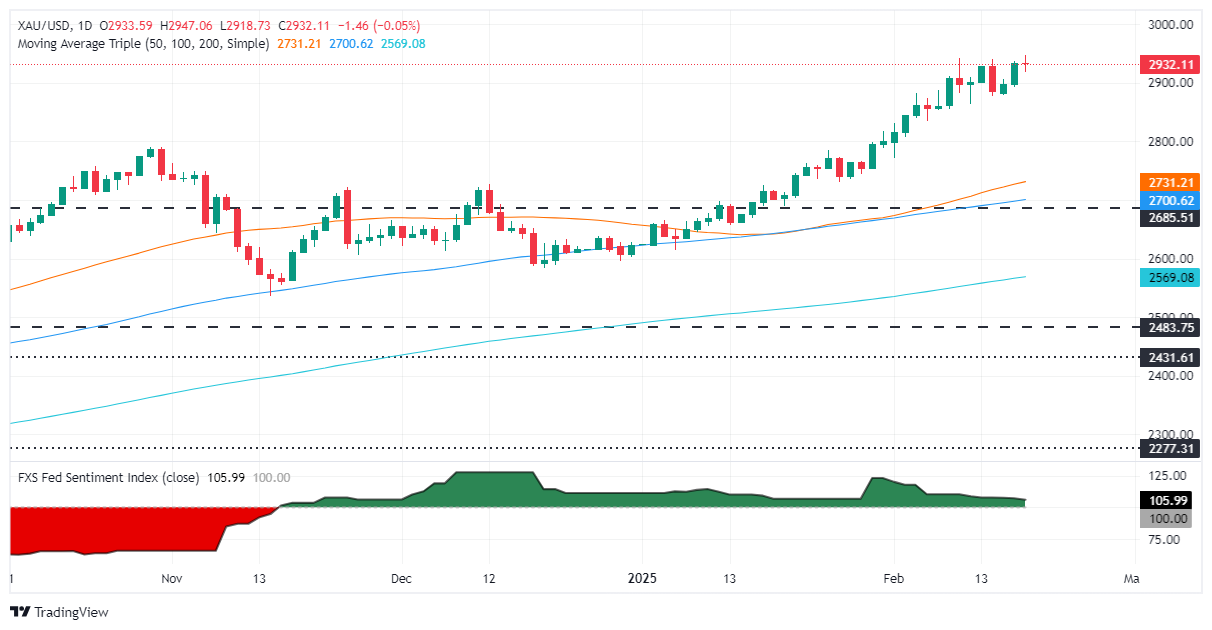Gold pulls back from record highs as Fed minutes dampen rate cut hopes
- Gold hits new all-time high as Trump’s tariff threats fuel trade war fears.
- Fed minutes reveal concerns over inflation risks, weighing on rate-cut expectations.
- Traders eye US jobless claims and S&P Global Flash PMIs for further market cues.
Gold prices retreated on Wednesday during the North American session after the latest Federal Reserve’s (Fed) monetary policy minutes showed that all policymakers voted to keep rates unchanged at the January meeting. XAU/USD trades at around $2,925, down 0.31%.
The minutes showed that Fed officials judged the dual mandate risks to be roughly balanced, while “some participants cited potential changes in trade and immigration policy as having potential to hinder the disinflation process.” Participants noted that some measures of inflation expectations “had increased recently.”
Earlier, Gold hit a new all-time high of $2,946 during the European session after United States (US) President Donald Trump revealed that he would impose 25% tariffs on automobiles, pharmaceuticals and chip imports.
The non-yielding metal edged up amid the trade war scenario. However, it turned negative after the release of the Fed’s minutes.
Market participants will watch the release of last week's initial jobless claims and S&P Global Flash PMIs.
Daily digest market movers: Gold price losses steam after reaching record high
- The US 10-year Treasury bond yield falls one and a half basis points (bps) and yields 4.535%.
- US real yields, which correlate inversely to Bullion prices, drop two-and-a-half basis points to 2.072%, a headwind for Bullion prices.
- Due to weather disruptions, January's US Housing Starts slid from 1.515 million to 1.366 million, or a 9.6% plunge.
- US Building Permits for the same period improved, rising from 1.482 million to 1.483 million, a 0.1% increase.
- Goldman Sachs upward revised XAU/USD price to $3,100 by year’s end as the investment bank said “structurally higher" central bank demand will add 9% to the price of the non-yielding metal.
- The World Gold Council (WGC) revealed that central banks purchased more than 54% YoY to 333 tonnes following Trump’s victory, according to its data.
- Money market fed funds rate futures are pricing in 40 basis points of easing by the Fed in 2025.
XAU/USD technical outlook: Gold price faces stir resistance and retreats
Gold price remains upwardly biased, though during the last seven days it has remained unable to clear the $2,950 hurdle. Price action seems overextended, further reinforced by buyers losing steam.
The Relative Strength Index (RSI) is about to exit overbought territory, which could lead to lower Gold prices. The first support would be the February 14 swing low of $2,877, followed by the February 12 daily low of $2,864.
On the other hand, if XAU/USD rises past $2,946, the first resistance would be the psychological $2,950, followed by $3,000.

Gold FAQs
Gold has played a key role in human’s history as it has been widely used as a store of value and medium of exchange. Currently, apart from its shine and usage for jewelry, the precious metal is widely seen as a safe-haven asset, meaning that it is considered a good investment during turbulent times. Gold is also widely seen as a hedge against inflation and against depreciating currencies as it doesn’t rely on any specific issuer or government.
Central banks are the biggest Gold holders. In their aim to support their currencies in turbulent times, central banks tend to diversify their reserves and buy Gold to improve the perceived strength of the economy and the currency. High Gold reserves can be a source of trust for a country’s solvency. Central banks added 1,136 tonnes of Gold worth around $70 billion to their reserves in 2022, according to data from the World Gold Council. This is the highest yearly purchase since records began. Central banks from emerging economies such as China, India and Turkey are quickly increasing their Gold reserves.
Gold has an inverse correlation with the US Dollar and US Treasuries, which are both major reserve and safe-haven assets. When the Dollar depreciates, Gold tends to rise, enabling investors and central banks to diversify their assets in turbulent times. Gold is also inversely correlated with risk assets. A rally in the stock market tends to weaken Gold price, while sell-offs in riskier markets tend to favor the precious metal.
The price can move due to a wide range of factors. Geopolitical instability or fears of a deep recession can quickly make Gold price escalate due to its safe-haven status. As a yield-less asset, Gold tends to rise with lower interest rates, while higher cost of money usually weighs down on the yellow metal. Still, most moves depend on how the US Dollar (USD) behaves as the asset is priced in dollars (XAU/USD). A strong Dollar tends to keep the price of Gold controlled, whereas a weaker Dollar is likely to push Gold prices up.

